Treats for Toys
Long Term Success (BRONZE)
Client Credits: Kellogg’s
Kellogg’s
Agency Credits: Leo Burnett
Agency: Leo Burnett, Toronto
Chief Creative Officer: Judy John
Group Creative Director: Noreel Asuro, Sean Ohlenkamp
Copywriter: Matt Williamson
Art Director: Mike Cook
Designer: Steven Tiao
Director, Creative Technologist: Felix Wardene
Flash Developer: Mary Shrestha
Agency Producer: Laurie Filgiano
Vice President, Group Account Director: David Moss
Account Director: Alison Macklin
Account Executive: Neil Rimmer
Planner: Trevor Thomas
Project Manager: Tracy Wightman
Photographer: Arash Moallemi
Production Company: BENT
Section I — CASE PARAMETERS
| Business Results Period (Consecutive Months): | Nov-Dec 2013, Nov-Dec 2014, Nov-Dec 2015 |
| Start of Advertising/Communication Effort: | November 2013 |
| Base Period as a Benchmark: | Jan-Oct 2013, Jan-Oct 2014, Jan-Oct 2015 |
| Geographic Area: | Canada |
| Budget for this effort: | $2 – $3 million |
Section IA — CASE OVERVIEW
Why should this case win in the category (ies) you have entered?
When Rice Krispies began to lose relevance with moms, and their sales began to fall, they looked to one of their key brand differentiators to turn the tide. Rice Krispies Treats had long been a staple in many Canadian households, but the brand had never truly leveraged them in a meaningful way.
The goal of this new campaign was to create a new holiday tradition for Canadian moms to share with their children. It was devised as a multi-year strategy to give moms a new reason to fall in love with the brand, by creating special holiday moments that they could share with their kids.
Section II — THE CLIENT’s BUSINESS ISSUES/OPPORTUNITIES
a) Describe the Client’s business, competition and relevant history:
Rice Krispies (RK) has been a staple in Canadians’ households since Kellogg’s first introduced the brand, in 1928. From its playful, animated mascots – Snap, Crackle & Pop – who brought to life the unique sounds the product makes in milk, to the sweet treats it could be used to create, RK had a special place in the hearts and pantries of Canadian families.
Out of sight, out of mind
As recently as 2008, the brand held an impressive 34.8% household penetration[1]. In 2009, with the launch of the brand’s new brand platform, Moms Just Know, RK shifted their focus from kids to moms and away from their mascots. Then, in 2011, due to budget cuts, RK was pulled from TV. Not surprisingly, the brand began to lose relevance. Without the presence of assets like the mascots and sounds, and with a smaller media footprint, the brand lost touch with moms. This caused a significant drop in household penetration, down to 27.9%, in 2013[2].
b) Describe the Client’s Business Issues/Opportunities to be addressed by the campaign:
Creating a new holiday tradition to help moms fall in love again
We needed to create a new reason to love RK, or risk losing a whole generation of Canadian moms and their kids. To do so, we looked at one of the brand’s unique attributes: treat making. In analyzing baking-related data, we learned that 71% of Canadians bake at least once a year and the most popular time to do so is around the holidays[3]. Looking to give moms a new reason to fall in love with the brand, we decided to create a new platform, leveraging our key differentiator, to create a new holiday tradition for moms and kids to share.
c) Resulting Business Objectives: Include how these will be measured:
RK’s holiday campaign launched in 2013, and has run for the past three holiday seasons. While only in market for about 6-weeks per year, Kellogg’s hoped that on top of the following campaign-specific objectives, the work would also have a halo effect across the rest of the year.
1.Increase share during important holiday period
In 2011-2012, the brand’s share during the holidays averaged 6.4[4]. The goal for this new holiday program was to establish RK Treats as a holiday baking tradition and increase our share to 7.0.
2.Stabilize household penetration
With the brand’s penetration numbers falling consistently since 2008, RK was very keen to use this program to stabilize their penetration numbers.
3.Drive brand love
Every two years, a brand tracker study is performed on key Kellogg’s brands. A primary objective for this campaign would be to drive three key brand measures: Awareness, Purchase Intent and Likelihood to Recommend.
[1] Client Sales Data
[2] Client Sales Data
[3] Dig Insights, “Winning Insights into Basking Usage & Attitudes,” Nov. 2015
[4] Client Sales Data
Section III — YOUR STRATEGIC THINKING
a) What new learnings/insights did you uncover?
Building upon Moms Just Know
In 2013, when we began exploration into a new holiday campaign for RK, the Moms Just Know, platform had been in market for nearly five years. The existing work had a nostalgic tone and highlighted the simple, emotional moments that mothers shared with their kids. We knew the eventual work would need to match that tone and manner, so we went looking for, and found, two key consumer insights that helped bring the holiday campaign to life:
1. During the holidays, time is precious
Between shopping and wrapping and cooking and baking and cleaning and prepping and celebrating, it’s hard to find time for special little moments with her kids.
2. The holidays are as much about giving back as they are about giving
Statistics Canada estimates that 40 % of the nearly $13 billion dollars donated every year is given in the last month of the year[5]. And leading the charge on this giving season are moms who are 25% more likely than other Canadians to donate[6]. The same study also found that as well as money, moms are also 58% more likely than other Canadians to donate their time.
b) What was your Big Idea?
The creative idea was built around a simple call to action: “Make a treat, make a difference.” We called it Treats for Toys. Moms would create a RK Treat with her child, submit a photo of their creation, and RK would donate a toy to a child for the holidays.
c) How did your Communication strategy evolve?
Looking for a deeper understanding
These insights helped lead RK’s new holiday success to a first year that exceeded expectations. Rather than simply continue the campaign, we wanted to learn more about our audience to see how we might be able to optimize the work.
To do so, we arranged a series of focus groups where we spoke to two different groups of young moms (younger [25-34] and older [35-44], with kids aged 2-8). When Moms Just Know launched, most of these moms weren’t moms yet, so we wanted to understand what – if anything – had changed about being a mom had changed in those 5-7 years.
These groups were extremely productive and helped us uncover three important insights that changed our thinking from year 1, and helped inform the next two years of the holiday campaign:
1. Traditional values, unique approach
In year 1, we focused heavily on nostalgia. But young moms told us that while they appreciated how their moms had raised them, they were fiercely independent and keen to chart their own course in everything from feeding to decorating to activities[7].
2. More doing, less showing
One key element to their new approach was not simply showing their kids how to do things, but having them participate throughout. To them, it was important that the time together go from ideation and planning right through to cleanup[8].
3. Busy is status quo
This represented a fundamental shift for our audience. We had focused on calm, simple moments for year 1 to play against the hectic holidays, but these younger moms told us that they embraced the chaos[9].
d) How did you anticipate the communication would achieve the Business Objectives?
To achieve our objectives, we built our communication strategy around three key pillars:
1. Generate break-through
With so many brands vying for mom’s attention during the holidays, we knew that getting her to notice was even more difficult than we’d anticipated. For year 2 and beyond we decided to make sure our work would stand out from the typical holiday creative.
2. Keep the focus online
Through our conversations with moms, we’d learned that while the overwhelming majority of the holiday activities she participated in with her kids were done offline, the majority of the inspiration for those activities was found online[10].
3. Speak to mother and child
After year 1, we decided to put a greater focus on creative that mom and child could enjoy together.
[5] Imagine Canada, “Holiday Giving Expected to Hit $5 billion,” November 2015
[6] Millennial Impact Report 2012
[7] The Sound, “Modern Moms: Parenting Exploration,” 2014
[8] The Sound, “Modern Moms: Parenting Exploration,” 2014
[9] The Sound, “Modern Moms: Parenting Exploration,” 2014
[10] The Sound, “Modern Moms: Parenting Exploration,” 2014
Section IV — THE WORK
a) How, where and when did you execute it?
Year 1
To match the look and feel of Moms Just Know we created a nostalgic :30 black & white video that depicted the experience of mother and child creating a treat together, meant to connect with moms during the holiday season. Print executions, online banners, as well as social posts accompanied the video. The call-to-action for all of our work in Year 1 asked moms to visit the campaign website to upload their creations.

The Characters
Another campaign element that was created in Year 1 was our holiday characters: Robot, Car, Dino, Bunny and Princess, each based on treat-making recipes. Each treat character was paired with a toy version to depict how treats could be turned into actual toys.
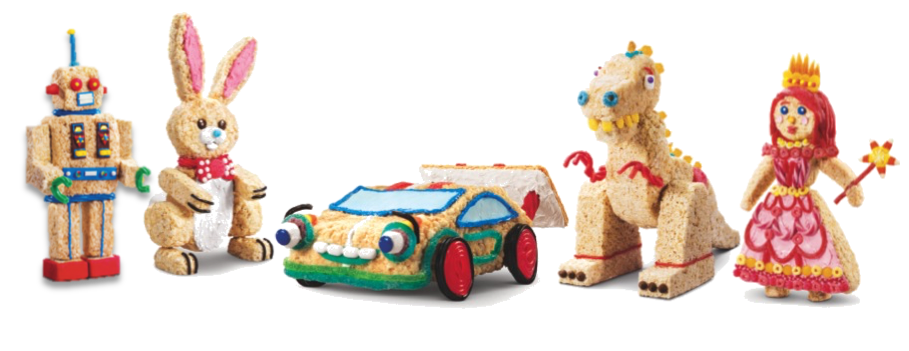
Year 2
In year 2, looking to directly address the “Speak to mother and child together” insight from our research, we decided to put our characters front and centre. We created short, animated :15 online video for each that featured the toy- and treat-versions of the characters interacting in unique and playful ways that matched the characteristics of the toy. The characters were also featured on our re-designed pack, and in a treat-making booklet that was distributed through Today’s Parent magazine and given away in-store.
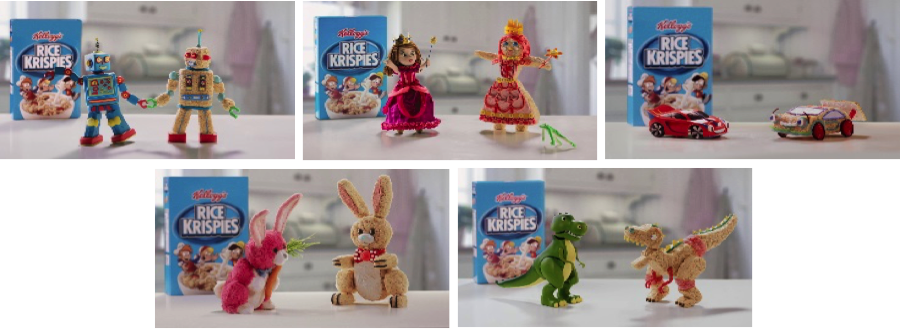
Our fun, new videos were built for sharing, and to address the “Keep the focus online” insight from research, we put a greater focus on these channels, featuring the characters and recipes in social posts along with hosting our first Twitter Party, to expand reach in this space. We also amended our campaign CTA to the hashtag, #TreatsForToys. Rather than uploading to the campaign site, moms could now simply post their submissions using the tag.
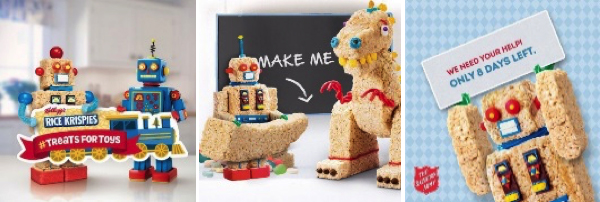
Year 3
To put an ever brighter spotlight on our characters, we made two keys changes in Year 3. First, we created an animated, step-by-step :30 video that featured our characters and detailed how the program worked. Second, we re-designed the packaging again, this time featuring the characters on the front of pack, and created a treat-making guide that was printed on the inside of the pack.
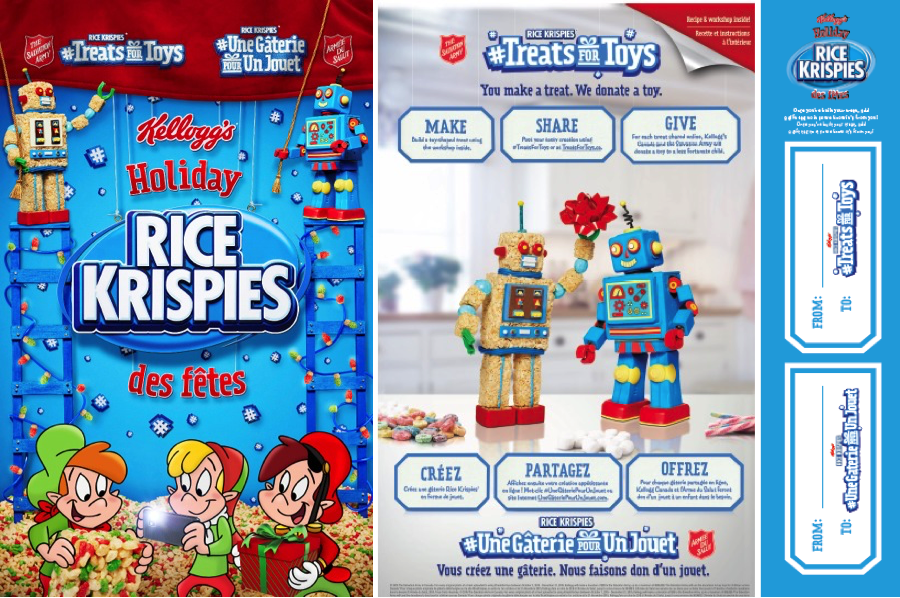
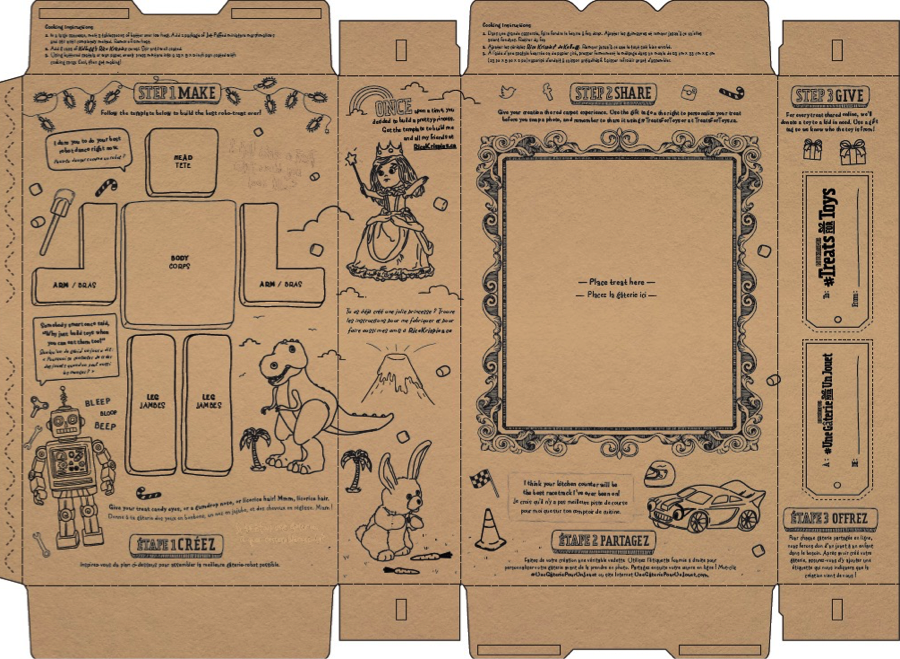
c) Media Plan Summary
Media used:
- Online video
- Pre roll
- Online media
- Social posts
- Social ads
- Twitter parties
- Magazine
- Website
- Packaging
- Collateral
Our online videos, the centrepieces of the campaign, were served sequentially to set up the program’s premise and then deliver fresh inspiration. A dynamic ad builder was employed to marry the videos with content that was hyper-relevant to both giving and holiday baking content from top publishers.
Initially, our media strategy was to find ways to connect with moms directly using online channels. Based on our research findings ahead of year 2, we altered our approach to speak to mom and child together. While we weren’t targeting kids directly, we knew our characters would have a great shot of grabbing their attention, so we focused on channels, times and places where mom was more likely to be with her children.
Section V — THE RESULTS
a) How did the work impact attitudes and behaviour?
Drive brand love
A Brand Lift study was completed in early 2016 to measure the effectiveness of the campaign, and found significant lifts were generated across key brand metrics[11]:
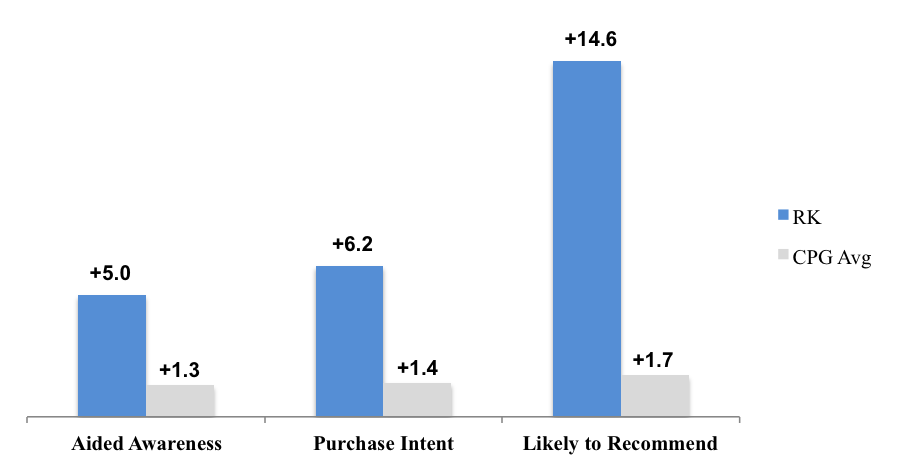
b) What Business Results did the work achieve for the client?
Increase share during important holiday period to 7.0
- Not only did RK’s share increase every year of the campaign, but it also far outpaced the brand’s average share value for the rest of the year[12]:
Stabilize household penetration
While sales were strong over the first two years of the campaign, due to larger than expected decreases in the rest of the year, penetration continued to fall in both year 1 and 2 of Treats for Toys. In 2015, however, largely driven by the campaign’s strongest year, the brand’s HHP grew +0.8 pts, to 27.7[13].
[1] Client Sales Data
c) Other Pertinent Results
Generate Awareness Online (Total results for all 3 years)
- 45.5 million media impressions[14]
- 76 million social impressions[15]
- 28,618 campaign-related tweets[16]
d) What was the campaign’s Return on Investment?
ROI: Over the three years of Treats for Toys, the campaign delivered an incremental sales return of 220%[17] better than 37.8% of all other food campaigns in the WARC database[18]:
[11] Comscore, Brand Lift Study, February 2016
[12] Client Sales Data
[13] Client Sales Data
[14] Media Agency
[15] Media Agency
[16] Media Agency
[17] Client Sales Data
[18] Warc.com, ROI Benchmarker
Section VI — Proof of Campaign Effectiveness
a) Illustrate the direct cause and effect between the campaign and the results
Prior to 2013, RK would run small holiday-focused creative, but there was never a dedicated campaign like Treats for Toys.
b) Prove the results were not driven by other factors
Campaign spend vs. history and competition:
Based on the success in share gains of year 1, the media budget increased in year 2, but remained relatively flat for year 3. The year 2 increase, while driving down ROI, helped increase the footprint of the campaign, which, in turn, drove share and helped increase penetration in year 3.

We expected this to negatively impact our results, but instead we saw our strongest performing year in terms of both share and penetration. We believe this proves the campaign’s ability to support price increases.
Pre-existing Brand momentum:
The brand was losing penetration, and share had flatlined when the campaign begun.
Pricing:
RK’s regular and promotional unit prices both increased every year of the campaign.
Changes in Distribution/Availability:
Distribution for RK remained the same as the previous year.
Unusual Promotional Activity:
There was no other unusual promotional activity during the holiday periods.
Any other factors:
Over the course of the three years, the category overall dropped 1% per year, so RK’s share gains out-performed the category.